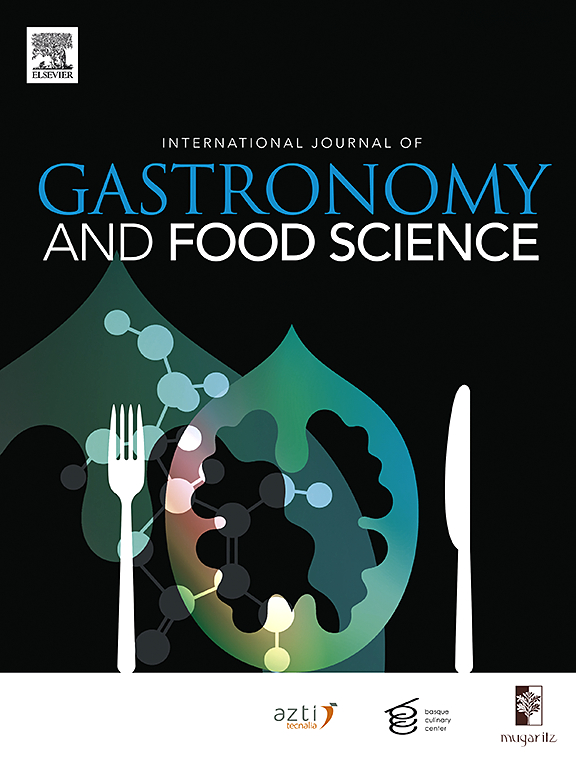电视烹饪节目和烹饪节目。因素分析和聚类分割
IF 3.6
2区 农林科学
Q2 FOOD SCIENCE & TECHNOLOGY
International Journal of Gastronomy and Food Science
Pub Date : 2025-09-17
DOI:10.1016/j.ijgfs.2025.101303
引用次数: 0
摘要
这项研究调查了烹饪类电视节目的观看习惯,如竞赛节目和食谱节目,以及它们对外出就餐和烹饪行为的影响。数据是通过葡萄牙250名成年公民的问卷调查收集的。数据分析包括基本统计、因子分析和聚类分析,以及所得聚类的特征。结果显示,当参与者外出就餐时,他们通常会在提供国菜的餐馆或快餐店用餐。大约三分之二的参与者在电视上观看烹饪节目,尽管频率很低,通常一周不到一次,尤其是在一天结束的时候。他们认为,这些计划可以影响饮食,因为它们提供了学习新食谱和准备食物的新方法的机会,包括重新利用剩饭剩菜来准备创新和创造性的饭菜。研究显示,烹饪节目鼓励观众在家做饭,准备更健康的食物,减少食物浪费。因子分析可以提取两个因素,一个与积极的看法有关,另一个与消极的看法有关。聚类分析显示了三组人:那些认为烹饪节目和节目没有用处的人,那些认为它们有教育意义的人,以及那些认为它们本质上是娱乐的人。最后,在健康状况的自我评价、外出就餐的频率和做饭的频率等变量上,观察到集群之间存在显著差异。总之,这项工作可以识别出与电视烹饪节目或烹饪节目的视觉化有关的三种不同的个体模式。本文章由计算机程序翻译,如有差异,请以英文原文为准。
Television cooking shows and culinary programmes – factor analysis and cluster segmentation
This study investigates the viewing habits regarding culinary television content, such as competition shows and recipe programmes, and their impact on eating out and cooking behaviours. Data were collected through a questionnaire survey in Portugal, on a sample of 250 adult citizens. Data analysis included basic statistics, factor and cluster analysis, and characterisation of the obtained clusters. Results showed that when the participants eat out, they usually do it in restaurants that serve national dishes or in fast food service providers. About two-thirds of the participants watch culinary programmes on TV, although with a low frequency, typically less than once a week, and especially at the end of the day. They believe these programmes can influence the diet because they constitute an opportunity to learn new recipes and new ways to prepare food, including reusing food leftovers to prepare innovative and creative meals. The study reveals that culinary programmes encourage viewers to cook more at home, prepare healthier meals, and reduce food waste. Factor analysis allowed the extraction of two factors, one linked to positive perceptions and the other to negative perceptions. Cluster analysis showed three groups of individuals: those who believe the culinary programmes and shows are not useful, those who find them educational and those who find them essentially entertaining. Finally, significant differences were observed between the clusters for variables such as self-evaluation of the health status, frequency of eating out, and frequency of cooking meals. In summary, this work allowed the identification of three differentiated patterns of individuals in relation to the visualisation of TV cooking shows or culinary programmes.
求助全文
通过发布文献求助,成功后即可免费获取论文全文。
去求助
来源期刊

International Journal of Gastronomy and Food Science
Social Sciences-Cultural Studies
CiteScore
5.30
自引率
10.50%
发文量
170
审稿时长
45 days
期刊介绍:
International Journal of Gastronomy and Food Science is a peer-reviewed journal that explicitly focuses on the interface of food science and gastronomy. Articles focusing only on food science will not be considered. This journal equally encourages both scientists and chefs to publish original scientific papers, review articles and original culinary works. We seek articles with clear evidence of this interaction. From a scientific perspective, this publication aims to become the home for research from the whole community of food science and gastronomy.
IJGFS explores all aspects related to the growing field of the interaction of gastronomy and food science, in areas such as food chemistry, food technology and culinary techniques, food microbiology, genetics, sensory science, neuroscience, psychology, culinary concepts, culinary trends, and gastronomic experience (all the elements that contribute to the appreciation and enjoyment of the meal. Also relevant is research on science-based educational programs in gastronomy, anthropology, gastronomic history and food sociology. All these areas of knowledge are crucial to gastronomy, as they contribute to a better understanding of this broad term and its practical implications for science and society.
 求助内容:
求助内容: 应助结果提醒方式:
应助结果提醒方式:


